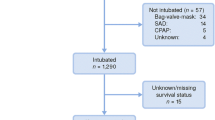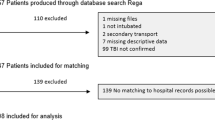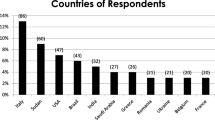Summary
Introduction: The prehospitaly initiated endotracheal intubation and controlled ventilation, is especially in multi-system-trauma cases, recognized to be the “gold standard”. Thus especially in view of the increasing demands being placed upon the quality of prehospital emergency treatment in general, the quality of such prehospital induced ventilation, is becoming of increasing importance. Thereby we must take into consideration the limited possabilities, which are afflicted with a high degree of uncertainess, which we have at our disposal to effectively evaluate the efficiency of emergency ventilation. The purpose of our study within a collective of severely traumatized patients, was to determine the quality of prehospitaly induced ventilation with regards to the adequacy of oxygenation and ventilation and as a result of our findings, to identify areas for procedural optimization.
Results: The prospective study over an one year period involved n = 104 trauma cases (male: 79; female: 25/age: 39,8 ± 20,8 years/ISS: 28,1 ± 15,3) whose prehospital emergency treatment required and included endotracheal intubation and controlled ventilation. All patients were subject to a prehospital pulse oxymetric monitoring, whereas none were subject to an objectivating apparatus monitoring of ventilation: 94,2 % of the patients were upon admission adequately oxygenated (paO2 > 80 mmHg); only one patient was hypoxemic (paO2 < 60 mmHg). 46,2 % were adequately ventilated (paCO2: 35–45 mmHg), 43,2 % however were hyperventilated (paCO2 < 35 mmHg), and 10,6 % hypoventilated (paCO2 > 45 mmHg). A statistical significant relation between hyper-/hypoventilation and the degree of severity of trauma as well as to the individual injury pattern was not evident. However with reference to age: The group of > 60 years of age were significantly more frequently hyperventilated (paCO2 < 30 mmHg: 31,2 %; p < 0,05). A noteworthy accumulation of hypoventilation was experienced amongst the group of patients, who during the prehospital treatment phase were hemodynamic instable (shock index > 1).
Conclusion: In summary it is evident, that as a rule, even very severe traumatized patients can prehospitaly be adequately oxygenated and that such oxygenation can with the assistance of pulse oxymetric monitoring be effectively controlled. Remaining problem is the emergency physicians ability to evaluate and control ventilation. The prehospital determination of minute volume (MV) in accordance with the presently valid recommendation: MV = 100–150 ml/kg body weight, in the majority of trauma cases results in inadequate ventilation. The introduction of an objectifying monitoring method is therefore urgently required.
Zusammenfassung
Die bereits präklinisch initiierte endotracheale Intubation und kontrollierte Beatmung ist heute, insbesondere bei polytraumatisierten Patienten, als allgemeiner therapeutischer Standard anerkannt. Vor dem Hintergrund gestiegener Anforderungen an die notärztliche Versorgung gewinnt deren Qualität zunehmend an Bedeutung. Allerdings sind die präklinisch zur Verfügung stehenden Möglichkeiten zur Beurteilung der Effizienz einer solchen Notfallbeatmung limitiert und mit einem hohen Unsicherheitsgrad behaftet. Ziel der vorliegenden Untersuchung war es deshalb, die Qualität notärztlicher Beatmung über die Beurteilung der O2-Versorgung und CO2-Entsorgung in einem Kollektiv schwer Traumatisierter zu untersuchen und mögliche Optimierungsansätze aufzuzeigen.
Ergebnisse: Aufnahme in die Studie fanden n = 104 Traumatisierte (männlich: 79, weiblich: 25; Alter: 39,8 ± 20,8 Jahre; ISS: 28,1 ± 15,3), die nach notärztlicher Versorgung, inklusive Intubation und kontrollierter Beatmung (FiO2: 1,0/manuelle bzw. maschinelle Beatmung) in unsere Klinik eingeliefert wurden. Ein präklinisches pulsoxymetrisches Monitoring zur Überwachung der Oxygenierung wurde bei allen Patienten, ein apparatives Monitoring der Ventilation hingegen bei keinem Patienten durchgeführt. Die im Schockraum noch unter notärztlichem Beatmungsregime gewonnene Blutgasanalyse ergab, daß 94,2 % der Patienten bei Klinikaufnahme adäquat oxygeniert (paO2 > 80 mmHg) waren; lediglich 1 Patient war hypoxisch (paO2 < 60 mmHg); 46,2 % der Patienten waren adäquat ventiliert (paCO2: 35–45 mmHg), 43,2 % hingegen hyperventiliert (paCO2 < 35 mmHg) und 10,6 % hypoventiliert (paCO2 > 45 mmHg). Ein statistisch signifikanter Zusammenhang zwischen Hyper- bzw. Hypoventilation und dem Schweregrad der Traumatisierung sowie speziellen Verletzungen bzw. Verletzungsmustern bestand nicht. Die Gruppe der über 60jährigen wurde signifikant häufiger extrem hyperventiliert (paCO2 < 30 mmHg: 31,2 %; p < 0,05), Patienten, die während der präklinischen Versorgungsphase hämodynamisch instabil waren (Schockindex > 1) hingegen signifikant häufiger hypoventiliert (paCO2 > 45 mmHg: 36,8 %; p < 0,05). Der Anteil der Patienten, die sowohl adäquat oxygeniert als auch ventiliert wurden, betrug 46,2 %.
Folgerungen: Auch bei schwer Traumatisierten kann die präklinische Beatmung hinsichtlich der O2-Versorgung adäquat durchgeführt und mit Hilfe der Pulsoximetrie effektiv überwacht werden. Die Bemessung des Atem-Minuten-Volumens (AMV) nach der anerkannten Empfehlung (AMV: 100–150 ml/kg KG) führt bei der Mehrzahl der Traumapatienten zu einer „inadäquaten“ CO2-Entsorgung. Die diesbezügliche Einführung „objektivierender“ Monitoringverfahren erscheint deshalb dringend notwendig.
Similar content being viewed by others
Author information
Authors and Affiliations
Rights and permissions
About this article
Cite this article
Helm, M., Hauke, J., Sauermüller, G. et al. About the quality of prehospital emergency ventilation – a prospective study in trauma patients. Unfallchirurg 102, 347–353 (1999). https://doi.org/10.1007/s001130050416
Published:
Issue Date:
DOI: https://doi.org/10.1007/s001130050416




